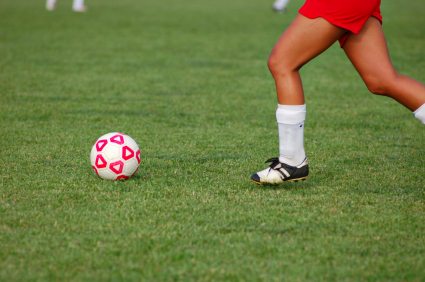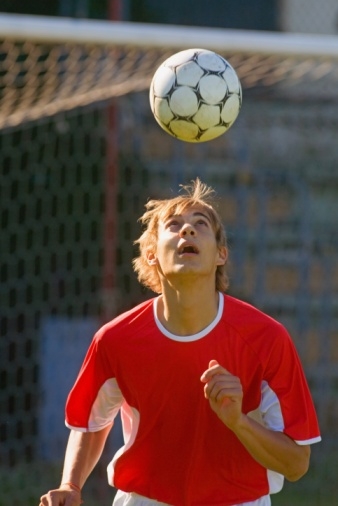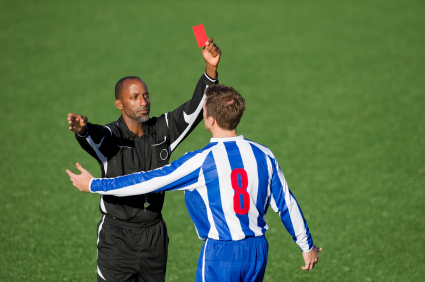Glossary of Terms
Pitch: Another word for the field.Sideline: The line that runs along the length of each side of the field, more commonly called the "touchline" in soccer.
Endline The boundary line extending from corner to corner along its width at each end of the field.
Goal area: the rectangular area (20 x 6 yd. on a full-size soccer field) marked within the penalty area (or inside the larger rectangle) and directly in front of goal which marks the area from which all goal kicks must be taken.
Penalty area or box: The large rectangular box (18 x 44 yards on a full-size field) in front of the goal that includes the goal area (6-yard box) which marks both where the goalkeeper is allowed to touch the ball with his hands and the area inside of which clear and obvious fouls committed by the defending team result in the award of penalty kicks to be taken from the penalty spot.
Penalty mark or spot: The spot 12 yards directly in front of goal from which penalty kicks are taken.
 Dribbling: The act of moving with a soccer ball by keeping it under control at the player's feet.
Dribbling: The act of moving with a soccer ball by keeping it under control at the player's feet.
Corner Kick: A direct free kick awarded the offensive team at a corner flag when the defending team is the last to touch the ball before it goes c0mpletely over the end line. There are two kinds of corner kicks: short (in which the player makes a short passe to a nearby teammate) and long (where the player tries to kick the ball in front of goal for a teammate to take a shot at goal from close range, either off his head or foot).
Goal Kick: A kick awarded when the attacking team is the last to touch the ball before it goes completely over the end line, which is taken from anywhere inside the goal area to restart play. After the kick is taken, the ball cannot be touched again by any player until it is outside of the penalty area. Goal kicks are usually taken by the goalie, although sometimes a defender will take the kick because he has a stronger kick and can send it further down the field towards the opposing team's goal.
Offsides: A violation which occurs when an offensive player is closer to the opponent’s goal than both the ball and the second-to-last opposing player (i.e. a defender) at the time that the ball is passed to that player by his or her teammate. Offsides calls are the most difficult for a referee (if only one official is on the field) or linesman (usually one on either side of the pitch responsible for one half of the field) to call. Players cannot be called offside if they are in their own half of the field or if they receive the ball from a throw-in, corner kick, or goal kick. When a player is called offside, the opposing team is awarded an indirect free kick.
Indirect Free Kick: a free kick awarded at the spot of fouls that are judged not to be serious such as obstruction, dangerous play or charging (non-contact fouls), as well as for offside. Indirect kicks must touch another player (either team) before the ball goes into the net in order to score.
Heading or Head-ball: Using the upper forehead to strike or control the soccer ball. Whether younger soccer players should be allowed to head is the subject of considerable debate.
50/50 ball:When a player from each team goes up to head a ball and each has a 50/50 chance of getting his head to the ball. 50/50 balls in which the two players' heads collide, or which result in a player's head being hit by the opposing player's elbow, or in the player falling and hitting his or her head on the ground, are responsible for a significant percentage of the concussions which occur in soccer.
Settling the ball: The ability to control the ball and prepare it for a following touch is one of the most essential skills in soccer. A bad first touch and the play is usually over for the attacker. Nearly all top players are known for having good control over the ball. There are two ways to control or settle the ball: receiving and trapping. Receiving means directing the ball off the player's chest into space away from the body. Trapping is stopping the ball right at your feet.
Marking: A player closely guarding a player from the opposing team, whether or not he has the ball, is said to be "marking" that player.
Tackling: Forcing a player to give away possession of the ball by either a block tackle (blocking the ball with a foot), poke tackle (extending a leg to poke the ball away from the opposing player), or slide tackle (when a defender throws himself to the ground, hip first, extending his leg to make contact with the ball). A slide tackle is the most spectacular and efficient type of tackle but also the most risky: if the tackle is missed and the player undercuts the opposing player before touching the ball, it is likely to result in a foul or, more likely, a yellow card and, if the tackle is from behind, a red card; if the tackle is missed completely, the defender will be completely out of the play, giving the attacking player and team a significant advantage.
Thow-in: After a ball goes out of bounds on the sidelines, the team that did not touch the ball last is allowed t o throw the ball into the field of play.
o throw the ball into the field of play.
Red card: A player shown a red card by the referee is immediately ejected from the game and may not be replaced. There are two types of red cards: "straight" red cards (immediate ejection for dangerous fouls such as tackling from behind, whether or not the player touches the ball or an elbow to the head of an opponent while going for a ball in the air (50/50 ball) or a "second yellow" (ejection of the player shown a second yellow card in the same game).
Yellow Card: The yellow card is a shown to a player who commits a flagrant foul, or, in some instances, in response to repeated fouls. A second yellow results in a red card and immediate disqualification.








